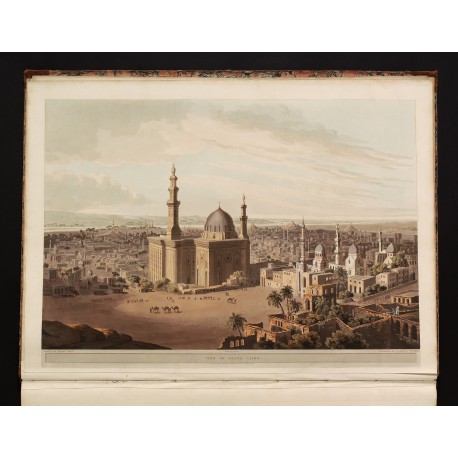Twenty-four Views taken in St. Helena, the Cape, India, Ceylon, Abyssinia & Egypt
- Subjects
- Archaeology, Ancient Near East & Egyptian
- Egypt - Description and travel
- India - Description and travel
- Authors/Creators
- Salt, Henry, 1780-1827
- Artists/Illustrators
- Havell, Daniel, died c. 1826
- Havell, Robert, the elder, 1769-1832
- Rawle, Samuel, 1771-1860
- Salt, Henry, 1780-1827
- Printers/Publishers
- Miller, William, active 1790-1812
- Other names
- Mountnorris, George Annesley, Earl of, 1769-1844
- Wellesley, Richard Colley Wellesley, 1st Marquess, 1760-1842
Salt, Henry, Sir
Lichfield, England 1780 – 1827 Alexandria, Egypt
Twenty-four Views taken in St. Helena, the Cape, India, Ceylon, Abyssinia & Egypt.
London, William Miller, 1809
broadsheet folio (545 × 760 mm), (25) ff., entirely engraved, comprising (1) aquatint title with dedication, printed in sepia (platemark 485 × 665 mm); and (2–24) twenty-four numbered, hand-coloured aquatint plates.
paper prints struck on a J. Whatman paper dated 1805; interleaves watermarked Ruse & Turners | 1805.
Spotting in margins of several plates; short tear in plate ix (early repair); otherwise in fine state of preservation. Binding hinges splitting; extremities rubbed and worn; cloth ties detached.
bound in contemporary roan-backed boards.
Fine copy of the first edition. A pupil first of the landscape painter Joseph Farington and later of John Hoppner, Salt had been appointed secretary and topographical draughtsman to George Annesley, Viscount Valentia (afterwards second Earl of Mountnorris), on his imperial tour of India, Ceylon, and Egypt. In the course of the tour (June 1802–October 1806), Salt made numerous drawings, about sixty of which were used to illustrate Valentia’s Voyages and Travels (three volumes, London 1809); others were utilised for the present work.
Before leaving England, Salt had conceived the idea of publishing a collection of large-scale coloured prints from his sketches, and advertisements for it appeared in London in 1802 and in Madras in 1803. On his return to London, Salt developed from his sketches a set of twenty-four wash drawings and these were translated into aquatints by a team of printmakers working under the supervision of Robert Havell.1 Salt’s Views appeared the following year, modelled on the Daniells’ Oriental Scenery (1795–1808), as a portfolio of plates, dedicated to the Governor-General of India, Richard Wellesley, 1st Marquess Wellesley, priced 26 guineas. And like the Daniells’ publication, a brief text explicating the plates was printed in small format as an accompaniment. The text volume is not offered here; Tooley writes, it ‘is not important and the work is usually to be found without it’.
The Indian views are half of the total illustrations. ‘In choice of subject, composition and colour, his drawings are very similar to those of Thomas and William Daniell, who had visited India a few years before. Yet at their very best his sketches show a vigour, energy and sensitivity to atmospheric effects which drawings by the former often lack’; they ‘make an authentic contribution to the English Romantic tradition’.2 Valentia had returned to England via Egypt; the last two plates – Salt’s ‘View of Grand Cairo’, taken from the gate of the Citadel; and a view of ‘The Pyramids of Cairo’ – were drawn in February and March 1806 respectively.
In this copy the plates are on a thick paper, mounted on guards and interleaved with card, features designated by Abbey as denoting a copy of an early issue. Abbey’s own copy was a late issue, post-1818; another such copy is in Cambridge University Library, Harley-Mason.bb.16 (plates watermarked 1819). A new edition was published by T. M’Lean in 1822.3
references R.V. Tooley, English books with coloured plates 1760 to 1860: a bibliographical account of the most important books illustrated by English artists in colour aquatint and colour lithography (London 1954), no. 440; John Roland Abbey, Travel in aquatint and lithography, 1770–1860 (London 1957), ii, no. 515 (without the text volume); Mildred Archer and Ronald Lightbown, India observed: India as viewed by British artists, 1760–1860 (London 1982), pp.67–68 nos. 96–99 (tile/dedication-page and plates 5, 7, 9)
1. Eighteen drawings together with three hand-coloured proof impressions are in the India Office Library; see Mildred Archer, British Drawings in the India Office Library, Volume ii: Official and professional artists (London 1969), pp.629–632 (drawings or proofs for all plates except nos. 2, 5, 22).
2. Mildred Archer, ‘Forgotten painter of the picturesque: Henry Salt in India, 1802–1804’ in Country Life 126 (no. 3272, 19 November 1959), pp.890–891.
3. Présence de l'Egypte: dans les collections de la Bibliothèque universitaire Moretus Plantin, catalogue of an exhibition (Namur 1994), pp.176–177 no. 68. Other copies in the British Library (shelfmark, X 433) and National Art Library (shelfmark, 110.C.31).







